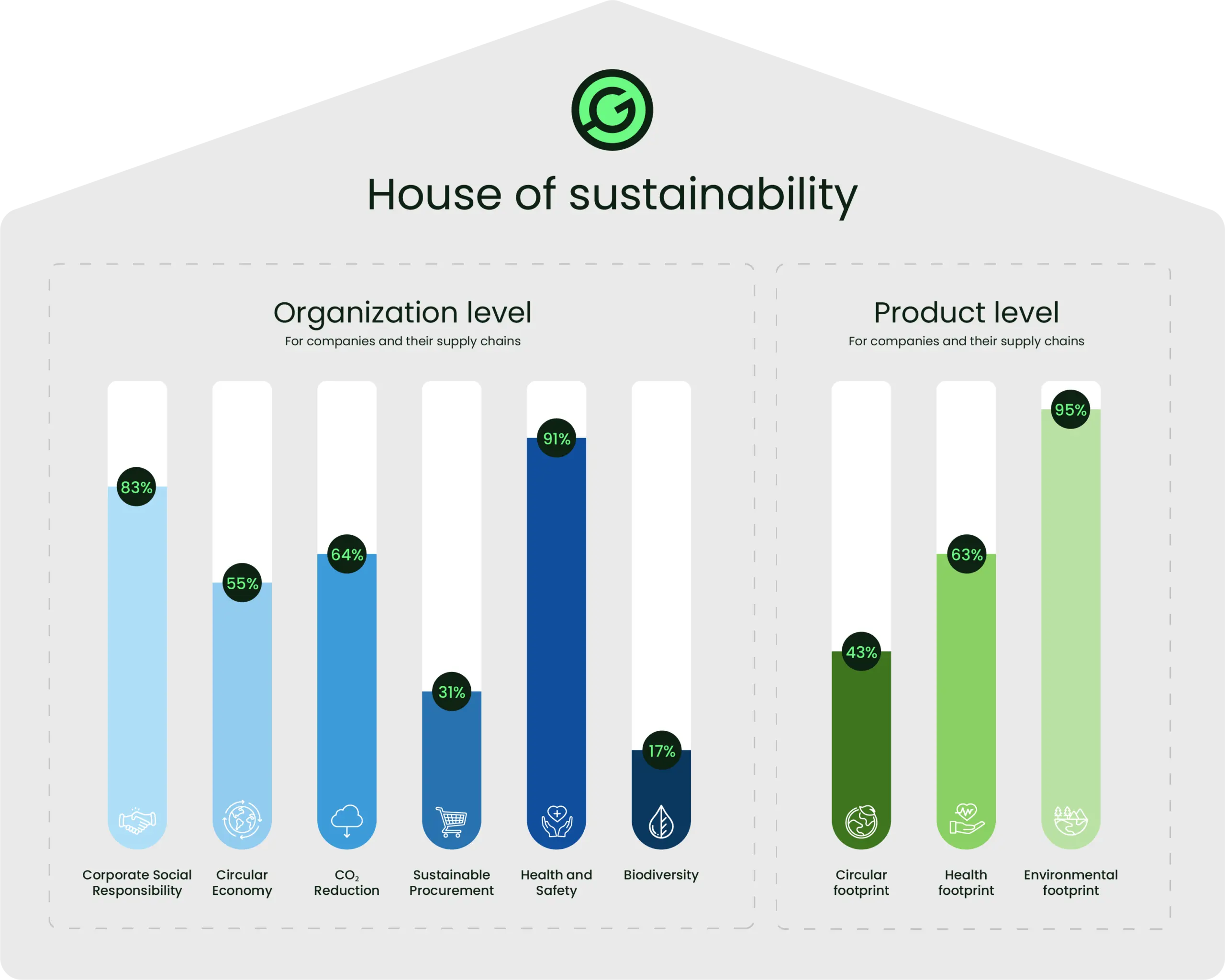Based on international standards, GSES has developed its house of sustainability

Responsibility
Economy
Reduction
Procurement
Safety
Footprint
Footprint
Footprint
The GSES benchmark translates ± 500 international ESG certificates into underlying KPI’s and makes them clear and therefore comparable! Organizations or products without certificates can perform assessments to demonstrate sustainability performance on the same benchmark.

Corporate Social Responsibility (CSR)
CSR is a strategic approach that influences both business operations and society. The GSES CSR pillar is based on the international standard ISO 26000:2011.
ISO 26000 defines CSR as an organization’s duty to manage the impact of its decisions on society and the environment through transparent, ethical behavior.
Supporting sustainable development:
Promoting health and societal well-being.
Considering stakeholder expectations:
Engaging with those affected by the organization’s actions.
Complying with laws and standards:
Following legal and ethical guidelines.
Integrating CSR throughout the organization:
Embedding responsible practices across the business.

Circular Enonomy
(Based on BS 8001:2017)
Understand how everything is connected. Consider the entire life cycle of products to reduce environmental, social, and economic impacts.
Embrace new ideas and solutions. Redesign products and processes to eliminate waste and drive circularity.
Take care of resources for future generations. Reduce, reuse, and manage materials responsibly.
Partner with suppliers, stakeholders, and the value chain. Working together helps optimize resource use and accelerate the shift to a circular economy.
Keep products and materials useful for as long as possible. Focus on maintenance, reuse, and recycling to maximize.
Be open about decisions that impact circularity. Communicate your sustainability efforts clearly and honestly with all stakeholders.
The Circular Economy pillar of the Global Sustainability Enterprise (GSE) Standard is based on the ISO 59000 series, particularly ISO 59004, ISO 59010, and ISO 59020. These standards work together to guide organizations in transitioning to a circular economy.

CO₂ Reduction
The CO2 pillar of the GSE Standard builds on ISO 14064-1:2019 and ISO 50001:2018. This standard sets specific requirements for reporting and verifying greenhouse gas (GHG) emissions and CO2 offset/compensation.
Energy use plays a major role in your carbon footprint. To effectively reduce it, follow these steps:

Measure and minimize:
Upload your existing certifications to see a quick overview of your current sustainability performance.

Set targets and offset:
Set clear reduction targets and compensate for remaining emissions through actions like tree planting.

Adapt and monitor:
Implement climate adaptation measures and continuously track your progress to stay on course with your sustainability goals.

Sustainable procurement
The Sustainable Procurement (SP) pillar in the GSE Standard, based on ISO 20400, provides a practical framework that guides organizations in aligning their work processes with sustainability goals. Buyers play a crucial role in this process by aligning their efforts with the organization’s strategic objectives, thereby enhancing the sustainability of the entire supply chain.
ISO 20400 outlines 12 core principles for sustainable procurement:
Take responsibility for your organization’s impact on society, the economy, and the environment.
Ensure clarity in decisions and actions that affect the environment, society, and the economy.
Promote ethical behavior throughout the supply chain.
Consider and respond to the interests of stakeholders impacted by purchasing decisions.
Stay vigilant against violations of laws and international standards within your supply chains.
Uphold internationally recognized human rights.
Avoid bias in all purchasing decisions, ensuring full and fair opportunities.
Pursue innovative solutions to meet sustainability goals and enhance procurement practices.
Assess needs carefully, purchase only what’s necessary, and seek sustainable alternatives.
Embed sustainability into all procurement practices to maximize positive outcomes.
Evaluate lifecycle costs, value for money, and the broader impact on society, the environment, and the economy.
Strive for ongoing improvement in sustainability efforts and encourage your supply chain to do the same.

Health and safety
The Health & Safety (HS) pillar in the GSE Standard, based on ISO 45001:2018, focuses on managing occupational health and safety.
Your organization must create safe and healthy working conditions for employees and others affected by its activities. This includes actively promoting and protecting both physical and mental health.
The HS pillar emphasizes employee welfare. It doesn’t cover product safety, material damage, or environmental impact, except where these issues pose risks to employees and stakeholders.


Biodiversity
The Biodiversity pillar follows the UN Guidance on Biodiversity Conservation and Sustainable Natural Resource Management.
While there isn’t yet an ISO standard for managing biodiversity at the organizational level, the GSES pillar aligns with the UN standard and the ISO High-Level Structure.
Key areas of focus include:

The impact of food, fiber, and fuel production on species and ecosystems.

Protection of endangered species and critical habitats.

